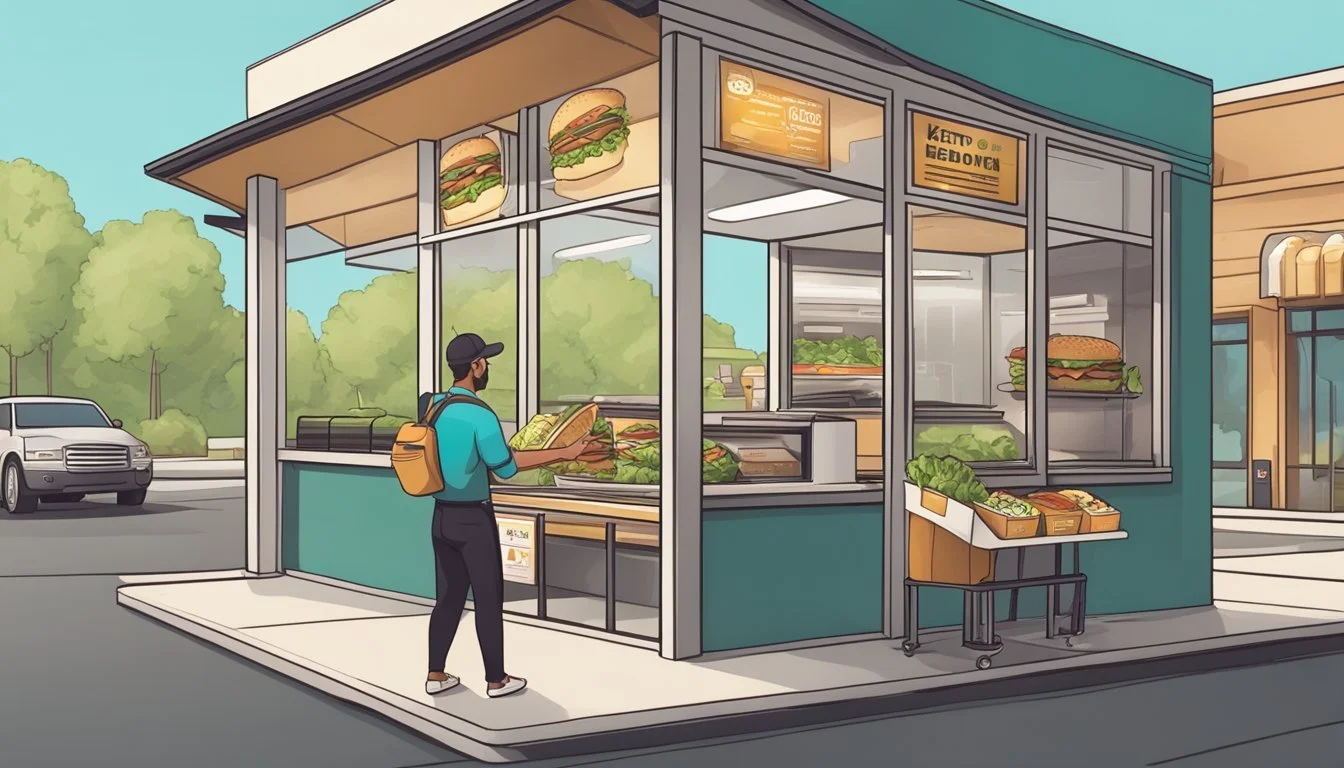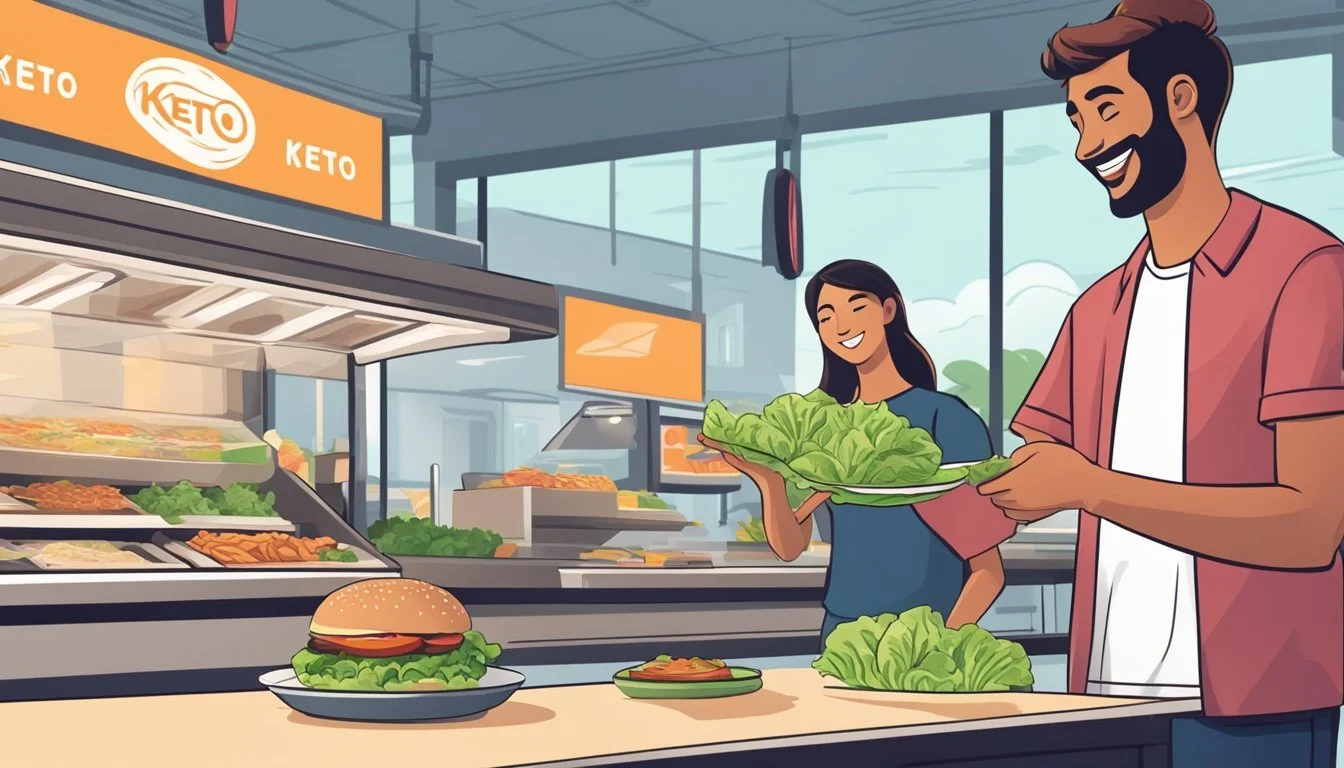Keto Diet: Navigating Fast Food Options for Low
Carb Eating
Maintaining a ketogenic diet while navigating the fast food landscape can seem challenging at first glance. The ketogenic, or "keto," diet emphasizes low-carbohydrate, high-fat foods with moderate protein. While typical fast food menus are often laden with carbs, there are viable options available that align with keto principles. Consumers can find keto-friendly alternatives at many fast food chains by making informed choices and customizing their orders.
When ordering at fast food restaurants, individuals should look for items that they can easily modify to fit their keto regimen. This often involves removing buns or wraps from burgers and sandwiches, opting for salads with high-fat dressings, and choosing grilled options over breaded or fried foods (What wine goes well with fried foods?). Awareness of hidden carbs in sauces, dressings, and sides is critical, as even small amounts can disrupt ketosis. Therefore, it entails paying close attention to the details of each meal choice to ensure it fits within the dietary boundaries of the keto diet.
Fast food chains increasingly acknowledge the demand for low-carb options, leading to an expanded availability of menu items designed to cater to a variety of dietary preferences, including keto. From bunless burgers to low-carb burrito bowls, there is a growing selection of meals that support the keto lifestyle. By prioritizing fats and proteins while minimizing carbohydrates, keto dieters can approach fast food with confidence, knowing there are choices that can sustain their dietary needs without compromising their goals.
Understanding Keto Diet Basics
Before diving into the details, it's important to understand that the ketogenic (keto) diet is a high-fat, low-carbohydrate diet that aims to shift the body's primary fuel source from glucose to ketones, produced from fat.
What is Ketosis?
Ketosis is a metabolic state in which the body burns fat for fuel instead of carbohydrates. It occurs when carbohydrate intake is significantly reduced, typically to 20 to 50 grams per day, prompting the liver to convert fat into fatty acids and ketones. These ketones then serve as an alternative energy source for the brain and other organs.
Macronutrients for Keto: Fats, Proteins, Carbs
The foundation of a keto diet is the macronutrient distribution, which is distinctly different from a standard diet. The typical ratio in a keto plan consists of:
70% to 80% fat
20% to 25% protein
5% to 10% carbohydrates
The focus on high-fat and low-carb intake is critical to maintaining ketosis. Keto dieters prioritize foods rich in healthy fats like avocados, coconut oil, and butter, while their protein intake remains moderate to prevent excess gluconeogenesis, which can pull them out of ketosis. Carbohydrates are drastically limited, and fiber-rich, low-net-carb vegetables are preferred to minimize the effect on blood sugar levels.
Guide to Fast Food on Keto
Seeking out fast food that aligns with a ketogenic lifestyle requires mindfulness of nutrition and the willingness to customize orders. It involves focusing on foods high in fats and proteins while keeping carbohydrate content low.
Identifying Keto-Friendly Fast Food Options
A ketogenic diet restricts carbohydrates to maintain a state of ketosis, where the body burns fat for fuel. Keto-friendly fast food often includes items that are rich in quality fats and proteins without added sugars or starches. When at a fast food restaurant, individuals can identify keto-friendly options by looking for:
Grilled Proteins: Look for chicken, beef, or fish that is grilled, not breaded or fried.
Salads: Ensure they don't include croutons, fruit, or sweet dressings.
Bunless Burgers: Opt for burgers without the bun or wrapped in lettuce.
Low-Carb Bowls: Bowls that include a base of greens, vegetables, and protein, without high-carb elements like rice or beans.
Navigating Menus: Tips and Tricks
To adhere to a keto diet while dining at fast food establishments, one must navigate menus strategically:
Customize Your Order: Request modifications such as no bun or swapping out sides like fries for a side salad.
Sauces and Dressings: Ask for these on the side or opt for mayonnaise, mustard, or other low-carb options instead of ketchup or sweet sauces.
Beverages: Choose water, unsweetened iced tea, or diet sodas instead of sugary drinks.
Here are some practical tips for common fast food venues:
Restaurant Keto-Friendly Option Customization Taco Bell Mini Skillet Bowl Skip the potatoes and any high-carb toppings. Burger Chains Cheeseburger (no bun) Lettuce wrapped, and specify no ketchup or onions if necessary. Chicken Joints Grilled Chicken Pieces Avoid fried and breaded options, and be cautious with dipping sauces.
Common Pitfalls and Misconceptions
One must be aware of the pitfalls and misconceptions surrounding keto fast food:
"Keto" Labels: Not all menu items labeled as "keto" are truly low-carb. Always check the nutritional information.
Hidden Carbs: Be wary of fillers in meat products and carbs in salad dressings or sauce packets.
Overconsumption: Portion control is key, even with keto-friendly options. High fat-content doesn't mean unlimited calories.
Popular Keto Choices at Major Fast Food Chains
When following a ketogenic diet, fast food can be a minefield of hidden carbs. However, with the right choices, such as bunless burgers and lettuce wraps, salads, and bowls, it is possible to enjoy a meal that fits within one's nutritional goals.
Bunless Burgers and Lettuce Wraps
McDonald’s: Patrons can order a Quarter Pounder but request it bunless, and optionally, in a lettuce wrap.
Burger King: The Whopper can be enjoyed bunless or wrapped in lettuce to reduce carbs.
Wendy’s: This chain offers the Baconator, which can be ordered without a bun and served with a lettuce wrap.
In-N-Out Burger: They have a "protein style" burger that replaces the bun with lettuce.
Salads, Bowls, and Protein-Rich Meals
Chick-fil-A: The Grilled Chicken Salad is a go-to for keto dieters, avoiding the use of sugary dressings.
Shake Shack: The Shack-cago Dog can be eaten without the bun, and they offer a selection of meat and cheese topped salads.
Custom Orders and Secret Menus
Taco Bell: While typical offerings such as tacos and burritos are high in carbs, a Mini Skillet Bowl with no potatoes can be a lower-carb option.
Chipotle: Keto eaters can create a bowl starting with a protein like pork carnitas (What wine goes well with pork carnitas?) or grilled chicken and add cheese, guacamole, and a variety of vegetables.
Ingredients to Watch Out for While Ordering
When navigating fast food menus on a keto diet, it’s crucial to identify hidden carbs and sugars, as well as to make smart choices about sauces and dressings, to maintain ketosis.
Hidden Carbs and Sugars
Fast food items might appear keto-friendly at first glance, but they can harbor hidden carbs and sugars. Patrons should be vigilant about ingredients such as:
Breading: Often found on fried chicken or fish, breading is high in carbs.
Buns and bread: Opt for lettuce wraps or go bunless to eliminate these carb-rich items.
Sweet dressings: Some salads are tossed in dressings that are high in sugar.
Dried fruit: A common ingredient in salads that significantly increases sugar content.
Patrons need to scrutinize each item for these hidden sources, as they can quickly accumulate and exceed daily carb limits.
Sauces and Dressings: Choose Wisely
Sauces and dressings significantly impact the final carb count of a meal. Here are common condiments and their considerations:
Ketchup and Honey Mustard: Typically loaded with sugar; usage should be minimized or avoided.
Ranch and Mayo: Generally low in carbs, yet it's wise to check for added sugars.
Mustard: Often a safe choice, being low in carbs, but portion control is key.
Sour Cream: Usually keto-friendly, though heavy-handed use can add up in calories.
When ordering, one can often ask for these condiments on the side to better control portion size and carb intake.
Alternative Fast Food Items and Swaps
For those adhering to a ketogenic diet, navigating fast food menus can be challenging. This section presents viable options and swaps that maintain ketosis, focusing on non-burger alternatives and keto-friendly beverages.
Non-Burger Keto Options
Fast food patrons following a keto diet may feel limited by burger-centric menus, but several chains offer non-burger alternatives that suit a low-carb lifestyle:
Grilled nuggets: An excellent protein-rich choice, grilled rather than breaded, minimizing carbs.
Bunless options: Most chains will accommodate a request for a burger or hot dog without the bun, often substituting with lettuce wraps.
Salads: Opt for greens loaded with cheese, bacon, and keto-friendly dressings, but always check for hidden carbs in toppings.
Here's an example of what one might order:
Restaurant Keto-Friendly Swap Wendy's Baconator, no bun, no ketchup KFC Grilled chicken pieces, no sides
Drinks and Beverages to Consider
Staying hydrated and refreshed on a ketogenic diet without added sugars and carbs is essential. Here are some beverage options:
Unsweetened iced tea: Almost universally available and carb-free.
Coffee: Enjoy it black or with heavy cream; avoid milk and sugar.
Water: Always the best option for staying hydrated without impacting ketosis.
Keto-compliant drinks one can readily find at fast-food chains include:
Drink Type Details Unsweetened Iced Tea Zero carbs, refreshing, and widely available Black Coffee Carb-free—consider adding heavy cream if desired
Customizing Your Meal for Optimal Nutrition
When adopting a ketogenic diet and facing the inevitability of fast food, one must master the art of meal customization to ensure nutritional goals are met while adhering to the diet’s high-fat, moderate-protein, and low-carbohydrate requirements.
Modifying Burgers: One can remove the bun and enjoy a bunless burger. They should opt for additional toppings like cheese, bacon, or avocado to increase the intake of fat, while being mindful of added sauces that could contain hidden sugars.
Opting for Salads: Salads are a viable option, as long as one is careful to choose dressings high in fat and low in carbs. Adding protein sources like grilled chicken or beef is recommended. They should incorporate high-fat toppings like cheese or nuts, and be generous with avocado, a source of healthy fats and fiber, which is integral to the ketogenic diet.
Vegetable Selections:
Choose: Leafy greens, broccoli, cauliflower
Avoid: Starchy vegetables like potatoes and corn
Snacking Wisely: For those needing a snack, fast food chains may offer options like parmesan crisps or packages of nuts, which are excellent sources of fats and have moderate protein content, aligning well with their dietary needs.
It's important to consume water or other zero-calorie beverages to stay hydrated without affecting carbohydrate intake.
By following these guidelines, individuals can maintain their ketogenic lifestyle even while turning to fast food options. They remain confident in their ability to navigate various menus, ensuring that both nutrition and satisfaction are not compromised.
Dining Out vs. Meal Prep: Striking a Balance
Individuals following a ketogenic diet often face the dilemma of choosing between dining out and meal prepping. The keto diet emphasizes low-carb, high-fat foods, and finding the right balance can be crucial for sustained success.
Meal Prep
Meal prepping allows for complete control over ingredients and macros, essential for staying in ketosis. It involves planning and preparing meals ahead of time. This ensures that meals are:
Customized to individual dietary needs
Convenient, reducing dependency on available food options
Generally more cost-effective than dining out
Dining Out
Conversely, restaurants provide variety and social enjoyment, which can be a welcome break from routine. When dining out on a keto diet, one should:
Review menus online in advance
Opt for dishes with high-fat and low-carb options such as:
Grilled meats (What wine goes well with grilled meats?) or fish
Salads with olive oil or full-fat dressings
Vegetables prepared without added sugars or starches
Avoid high-carb staples like bread, pasta, and sugary desserts
Achieving Balance
One can maintain a ketogenic lifestyle while enjoying the perks of both dining out and meal prepping by:
Prioritizing meal prep when time and conditions allow
Selecting keto-friendly restaurants and dishes when eating out
Equipping oneself with the knowledge of suitable food choices
Being flexible and adapting based on circumstances
Efficiently alternating between meal prepping and restaurant dining can make adhering to a keto diet both enjoyable and manageable.
The Long-term View: Sustainability of Keto at Fast Food Restaurants
When considering the keto diet's long-term sustainability in the context of fast food, it is crucial to evaluate both the challenges of maintaining a strict dietary regimen and the need for flexibility within this lifestyle.
Incorporating Flexibility in Your Diet
In navigating the keto diet through fast food options, individuals face the challenge of staying within the macronutrient framework that fosters ketosis. Fast food menus often contain limited keto-friendly items, which are typically high in fats and low in carbohydrates. To incorporate flexibility:
Identify Substitute Options: Patrons can choose to modify orders by removing high-carb ingredients like buns or sauces.
Look for 'Hidden' Carbs: One should be cautious of items that may seem keto but contain sugars or starches, like breaded meats or salad dressings.
Maintaining Commitment to Keto Lifestyle
Commitment to a ketogenic lifestyle amidst the abundance of fast-food choices demands discipline and a proactive approach. To maintain this commitment:
Plan Ahead: Reviewing nutritional information online beforehand can help one make informed choices that align with the keto diet.
Favor Whole Foods: Whenever possible, opting for whole-food options like grilled meats and fresh salads can make adhering to the keto diet at fast food restaurants more manageable.






